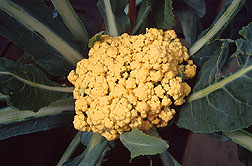High-Beta-Carotene Cauliflower
An orange cauliflower plant found growing spontaneously in a Canadian field nearly 30 years ago could provide scientists with important clues for boosting the nutritional value of many different crop species.
Several years ago, ARS plant molecular biologist David F. Garvin heard about the anomalous cauliflower in a chance conversation with a colleague.
"No one had investigated the molecular basis of this mutant cauliflower or its implications for improving the nutritional value of foods," says Garvin. He works at the U.S. Plant, Soil, and Nutrition Laboratory in Ithaca, New York.
Garvin is now studying the plant. He says, "Our last chemical analyses indicated that beta-carotene concentrations in some tissues of the mutant can actually be several hundredfold higher than in normal cauliflower."
Usually, a serving of cauliflower—a member of the cabbage family—has only a few micrograms of beta-carotene. Carrots have several thousand times more.
Beta-carotene belongs to a class of compounds known as carotenoids. It is an orange pigment found in carrots and other fruits and vegetables. "The mutant cauliflower produces so much beta-carotene that it turns some normally white parts of the plant orange," says Garvin.
Beta-carotene and some other carotenoids have antioxidant properties that may reduce the incidence of cardiovascular disease and certain types of cancer. Beta-carotene is also an important source of vitamin A.
Unfortunately, many plants important to the human diet do not contain much beta-carotene. This has been a factor contributing to serious problems with vitamin-A deficiency in many parts of the world.
The situation could be addressed by developing crop varieties richer in beta-carotene. In plants, the production of carotenoids like beta-carotene requires a series of tightly controlled steps coded by different genes.
"Somehow, the cellular programming for carotenoid production in the mutant cauliflower has been thrown askew, causing it to produce large amounts of beta-carotene in plant parts that don't normally contain the compound," Garvin says.
He is using the mutant cauliflower as a model system for unraveling the biochemical and molecular basis of carotenoid production in crops. Various characteristics of this mutant have led him to assume that the altered gene it harbors may somehow act as an important switch for turning carotenoid production on or off in plants.
"We know that the programming error is due to an alteration in a single gene," says Garvin. "However, our preliminary molecular studies now suggest that this gene alteration may in turn influence the activity of several other independent genes required for synthesizing beta-carotene."
Garvin hopes that ultimately the research will provide key information needed to genetically engineer increased carotenoid content in other, more important crops that have minimal amounts of these compounds, such as wheat and rice. By doing so, he hopes to take an important step toward creating foods that may help reduce the incidence of vitamin-A deficiency, cardiovascular disease, and cancer.— By Hank Becker, Agricultural Research Service Information Staff.
This research is part of New Uses, Quality, and Marketability of Plant Products, an ARS National Program described on the World Wide Web at http://www.nps.ars.usda.gov/programs/cppvs.htm.
David F. Garvin is at the USDA-ARS U.S. Plant, Soil, and Nutrition Laboratory, Tower Rd., Ithaca, NY 14853; phone (607) 255-7308, fax (607) 255-2459.
"High-Beta-Carotene Cauliflower" was published in the July 1999 issue of Agricultural Research magazine.







